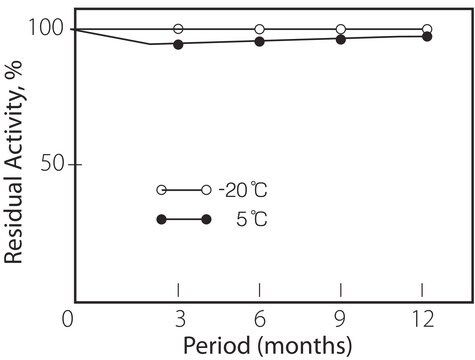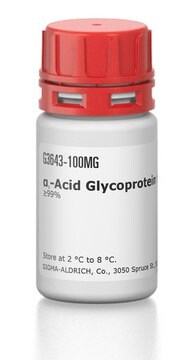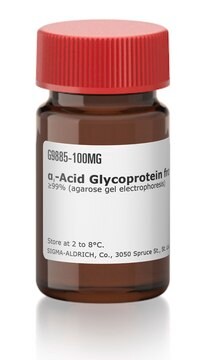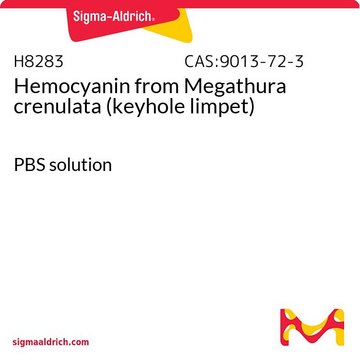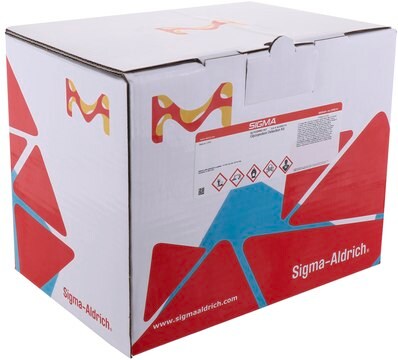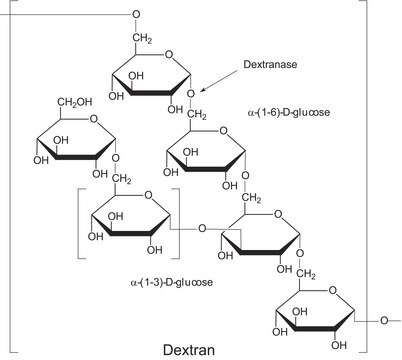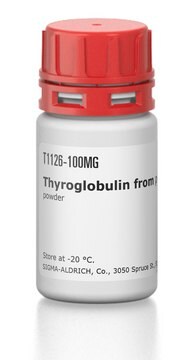추천 제품
생물학적 소스
Saccharomyces cerevisiae
Quality Level
Grade
for proteomics
제품 라인
BioReagent
양식
lyophilized powder
분자량
60 kDa
농도
≥0.5 mg/vial protein (E1%/280)
저장 온도
2-8°C
유사한 제품을 찾으십니까? 방문 제품 비교 안내
애플리케이션
Invertase Glycoprotein Standard has been used:
- to generate N-linked glycan library
- as a negative control to study the binding of lectins to high mannose structures
- for sample pre-treatment in proteomic analyses to study drug-induced toxic epidermal necrolysis
The Invertase Glycoprotein Standard can be used to demonstrate N-glycosylation using PNGase F with both in-solution and in-gel procedures. The extent of deglycosylation can be assessed by mobility shift on SDS-PAGE gels.
Used in the production of confectionary foods and artificial honey.
생화학적/생리학적 작용
Invertase hydrolyzes sucrose into glucose and fructose yielding a colorless product, unlike acid hydrolysis which produces colored products.
기타 정보
Invertase is an enzyme that catalyses the hydrolysis of sucrose into fructose and glucose. Invertase Glycoprotein Standard is the periplasmic (glycosylated form, external invertase) with 50% of its mass as polymannan. Since yeast can provide an alternative system for protein glycosylation that is similar to mammalian systems, periplasmic invertase is often used as a model for the study of the function of oligosaccharides in glycoproteins and for studies on glycoprotein biosynthesis.
신호어
Danger
유해 및 위험 성명서
예방조치 성명서
Hazard Classifications
Resp. Sens. 1
Storage Class Code
10 - Combustible liquids
WGK
WGK 3
개인 보호 장비
Eyeshields, Gloves, type N95 (US)
이미 열람한 고객
Proteomic kinetic analysis of blister fluid and serum in a patient with drug-induced toxic epidermal necrolysis. A comparison with skin immunohistochemistry
Paquet P, et al.
Current Drug Safety (2012)
A lectin affinity workflow targeting glycosite-specific, cancer-related carbohydrate structures in trypsin-digested human plasma
Analytical biochemistry (2011)
Glycan characterization of the NIST RM monoclonal antibody using a total analytical solution: From sample preparation to data analysis
Hilliard M, et al.
MAbs (2017)
Rachel Morissette et al.
Bioscience reports, 32(6), 577-586 (2012-09-04)
In eukaryotes, GPI (glycosylphosphatidylinositol) lipid anchoring of proteins is an abundant post-translational modification. The attachment of the GPI anchor is mediated by GPI-T (GPI transamidase), a multimeric, membrane-bound enzyme located in the ER (endoplasmic reticulum). Upon modification, GPI-anchored proteins enter
Nayan J Sarma et al.
Nucleus (Austin, Tex.), 3(6), 508-515 (2012-10-11)
Transcriptional regulation is a complex process that requires the integrated action of many multi-protein complexes. The way in which a living cell coordinates the action of these complexes in time and space is still poorly understood. Recent work has shown
자사의 과학자팀은 생명 과학, 재료 과학, 화학 합성, 크로마토그래피, 분석 및 기타 많은 영역을 포함한 모든 과학 분야에 경험이 있습니다..
고객지원팀으로 연락바랍니다.

